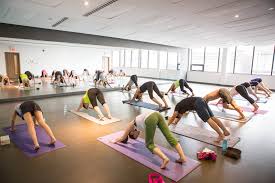Blog
2021-06-11
The relaxing nature of yoga helps relieve stress, reduce anxiety, improve sleep and balance your mood. How often should you do yoga? The real answer to this question is the frequency that feels right to you.
A beginner should focus on forming a habit, not just on results. Yoga almost never gets great results in a short period of time. Yoga is an exercise that takes a long time to produce results. Yoga teachers suggest that we practice three to five times a week for steady progress. A study found that people who practiced yoga at least five times a week had the best results for health, sleep, and well-being. Of course, depending on your schedule, you'll need to do yoga regularly at first, even an hour a week can be beneficial. The more you do yoga, the more progress you will make. As you practice, you will find that practicing for half an hour a day is likely to make more progress than practicing for two hours a week.
What if you could only practice once a week? You'll definitely benefit, but the benefits may not last as long as practicing three to five times a week. On the other hand, if you want to practice every day, you need to vary your practice so that you don't pull any muscles, joints or ligaments. Doing it too fast can lead to injury and hinder your progress, the opposite of what yoga is supposed to help you.
It all depends on your time, most people practice for 15-60 minutes. It's not a one-size-fits-all, and if you only practice for 10-15 minutes each day before work or after exercise, that's great too.
On the other hand are the long hours of yoga practice, and sometimes you may feel like you want to practice and adapt to each pose. Sometimes that will give you good results, but you may end up doing too much and overloading your joints, so it's better to do a few standard postures, even a few, that will make a difference, rather than a lot of incorrect postures. Pay attention to your postures and take deep breaths throughout the practice. The good thing about practicing for a long time is that you have enough time for each pose and you can end up doing a longer relaxation, which is good for your body and mind.

If your goal is to lose excess weight, physical health and nutrition are also crucial. You can do two hours of high-intensity yoga a day and still gain weight if your diet isn't under control. Yoga is not as good for weight loss as running, dancing, or cardio because it burns fewer calories than high-intensity workouts. However, it can still be part of a successful weight management program. You can take yoga classes 3 to 6 times a week (at least 1 hour each time), depending on how often you need to lose weight.
If you want to become stronger through yoga practice, you should focus on the type of yoga rather than the time of day. You can take a strength-based class, such as power flow yoga or power yoga, and point out that a class that focuses on physical exercise will change muscle strength. To build muscle strength and strength, focus on a dynamic and challenging yoga style. Ashtanga, Power, Vinyasa and hybrid asanas are suitable styles. Hot and Bikram yoga can also increase muscle mass. Yogis recommend attending these classes three times a week, not overdoing them, and making sure to give your muscle tissue a proper break in between to recover from the strenuous workouts.
It depends on your body. Some people are naturally more pliable. For them, even one or two one-hour yoga classes a week are enough to keep the body supple. Others need to practice every day to soften their muscles and joints.
Each yoga style increases the effect of flexibility and softness in the joints. If high flexibility and splits are your ultimate goals, Yin Yoga will offer longer retention. There is no limit to how often you can practice. You can exercise by doing yoga twice a day if you need to.

Do yoga every day, anytime, anywhere. The breathing techniques of yoga have an immediate calming effect. But in the long run, regular and consistent practice will bring greater benefits. You'll feel more control over your energy levels, mood, and focus.
If you are busy and don't have time to practice, even a short, gentle practice of asanas before bed can have an immediate positive impact on sleep quality. Using simple pranayama techniques, such as three-part yoga breathing, in the workplace or during commuting can relieve stress and calm the nervous system.
Therefore, how often you should do yoga sport depends on your time and what you want to achieve. Hope our article will help you.
FITOP specializes in the production of yoga equipment, including yoga mat, yoga ball, yoga tile, you can contact us to get the yoga equipment you want.
Request a Quote
Request a Quote